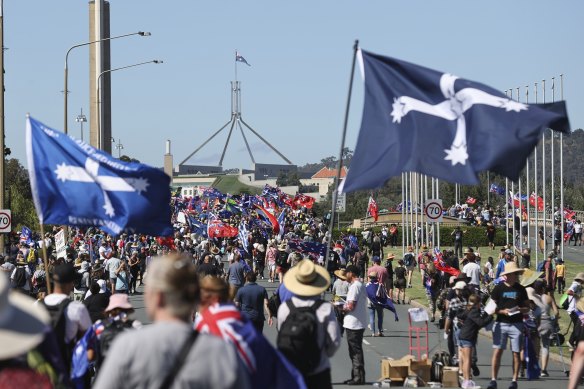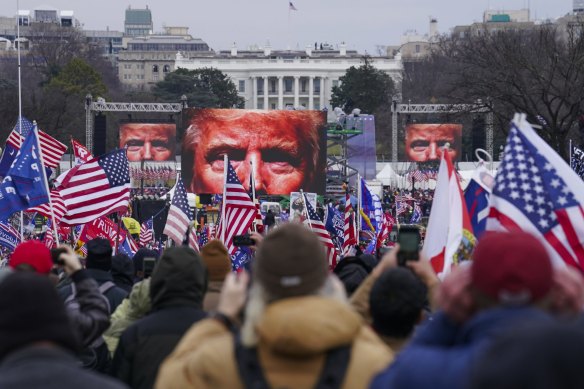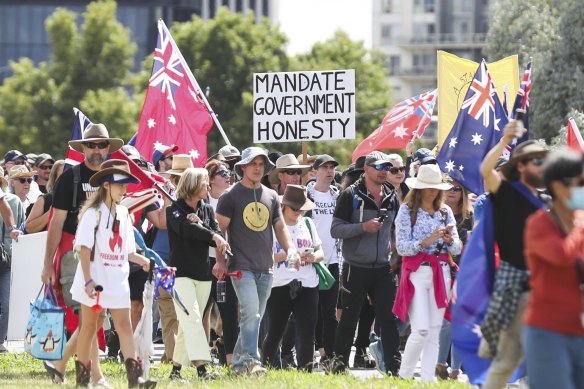This was published 2 years ago
Opinion
Deplorables? No. These convoy protesters should not be ignored
Chris Uhlmann
Former Nine News political editorIf Logan County in West Virginia is remembered in America at all, it’s as a battleground in the nation’s most infamous family feud, between the Hatfields and the McCoys.
It ran for nearly 30 years, from 1863, beginning with the murder of Asa McCoy by a Confederate guerrilla unit called the Logan Wildcats, led by William Anderson “Devil Anse” Hatfield.

Convoy to Canberra protesters march towards the parliamentary triangle in Canberra.Credit: Alex Ellinghausen
I found a statue of Devil Anse standing over his grave in November 2016, tucked away in a river valley on the side of a steep hill. A Confederate flag fluttering nearby stood as testament that not all the rebels in the county had been buried.
The presidential campaign was nearing its end and I had come in search of Trump supporters. The mother lode was in Logan, where 79.6 per cent would go on to cast their vote for him.
Coal made Logan rich and added another bloody chapter to its violent history. The brutal attempts to suppress unions by company towns such as Logan led to what’s known as the Battle of Blair Mountain in 1921. It’s claimed that more than 1million shots were exchanged between miners and muscle hired by the bosses.
To distinguish themselves in the fight, the miners tied red handkerchiefs around their throats and would be immortalised as the Red Neck Army.

Trump supporters rally in Washington. Credit: AP
By 2016, Logan’s glory and riches were gone. There had been no real wage increase since the 1970s. The coal industry was being shuttered. The county had the nation’s second-lowest household income and less than half of the adults had a job.
The defining mood in Logan was rage; at politicians who had abandoned them and a mainstream media that downplayed, dismissed, mocked or ignored their concerns. These were the people Hillary Clinton dubbed “deplorables”.
Given politics as usual had broken them, all they wanted from Trump was for him to go to Washington and break it. He delivered, which might help demystify why his base was unassailable.
I caught a glimpse of Logan County close to home over the last two weekends, wandering through the Convoy to Canberra crowd as it marched on Parliament. Quite a few stopped me to make it clear I was a part of a media they held in contempt, but most were polite.

Most of the Convoy to Canberra marchers looked like they had just wandered out of Bunnings.Credit: Alex Ellinghausen
“We’re not all rednecks,” said one.
That was evident to anyone who bothered to look. Most of the crowd looked like they had just wandered out of Bunnings. There was a myriad of grievances, but most opposed vaccine mandates. All were sick of being subjected to constant and mercurial government interference in their lives.
There were extreme elements. Ironically, the only ones wearing masks were a handful from the neo-fascist group Proud Boys. There was also a fair littering of conspiracy theories scrawled on signs and muttered in conversation.
Some have undoubtedly behaved boorishly, a handful lawlessly, but the vast majority were peaceful. I was in the crowd at the March4Justice rally outside Parliament last year and don’t judge it by the woman in the black balaclava who spent half an hour standing centimetres from my face yelling that I was “a c--t” while her friend taped the encounter.
Something important is happening. It could grow. It might not stay peaceful.
The people in the Convoy to Canberra looked like middle Australia. There was a smattering of Indigenous Australians and ethnic groups waving the flags of many nations. If anything defined them, it was that most didn’t appear to work in jobs they could easily do from home. Once we would have called them working class.
The crowd was massive. Trying to judge its size is a mug’s game, but it was easily the biggest I have seen in 30 years of covering protests in the capital. There is also compelling evidence that they are a minority, given nationwide vaccination rates sit above 90 per cent.
But, as in Logan, something has broken, and we need to understand it. This is not a crowd that takes to the streets without extreme provocation. They are reacting to extraordinary interference in their lives. If you don’t have a right to protest being locked in your home, robbed of employment, separated from your family, forbidden from travelling overseas, barred from returning to Australia and forced to take a vaccine to keep your job, then what does constitute a just cause?
Given the welter of national and state discrimination laws are not written for these people, their only redress is to take their grievance to the street and exercise their right to peaceful demonstration.
They can also express their rage at the ballot box. Nationally they are too small to move mountains, but there are tens of thousands of them. In a close election, a few hundred votes in marginal seat might change a government.
Something important is happening. It could grow. It might not stay peaceful. Politicians and the media should try to understand what is going on. That begins by listening to people and talking to them, not at them.
Chris Uhlmann is political editor for Nine News.
The Morning Edition newsletter is our guide to the day’s most important and interesting stories, analysis and insights. Sign up here.